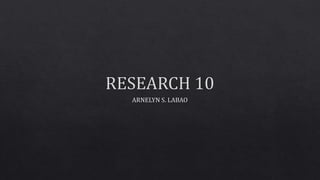
ABSTRACT research yheng. pptx
- 6. It is a short summary of your completed research. It is intended to describe your work without going into detail. Abstracts should be self-contained and concise, explaining your work as briefly and clearly as possible. An abstract summarizes, usually in one paragraph of 300 words or less, the major aspects of the entire paper in a prescribed sequence that includes: 1)the overall purpose of the study and the research problem(s) you investigated; 2) the basic design of the study; 3)major findings or trends found as a result of your analysis; and 4) a brief summary of your interpretations and conclusions.
- 7. Descriptive. Usually a short paragraph (<100 words), a descriptive abstract outlines the research question, methods, and work scope. It does not discuss the results or conclusions.
- 8. Informative. The most widely used category, an informative abstract constitutes a complete document that explains all the primary arguments, results, evidence, and conclusions. The length varies based on journal requirements and other submissions guidelines; however, it is usually less than 10% of an article’s length (~200–300 words).
- 9. Critical. Primarily reserved for literature and systematic reviews, a critical abstract is rarely used. Its role is to explain the angle from which a person is critiquing the source literature discussed by a review. Unlike the other two types of abstracts above, a critical summary may include evaluative statements and recommendations.
- 11. • let readers get the gist or essence of your paper or article quickly, in order to decide whether to read the full paper; • prepares readers to follow the detailed information, analyses, and arguments in your full paper; • helps readers remember key points from your paper; • facilitates electronic database indexing; • highlights the key points of an academic paper;
- 12. • for proposals, indicates the intended direction of a study; • provides the scope of a study so that peers can decide whether to review a manuscript; • along with a cover letter, is screened by editors in the first round of the editorial review process; and • is skimmed by other academics seeking potential sources to cite or read further.
- 13. 1. The context or background information for your research; the general topic under study; the specific topic of your research. 2. The central questions or statement of the problem your research addresses. 3. What’s already known about this question, what previous research has done or shown.
- 14. 4. The main reason(s), the exigency, the rationale, the goals for your research (Why is it important to address these questions? Are you, for example, examining a new topic? Why is that topic worth examining? Are you filling a gap in previous research? Applying new methods to take a fresh look at existing ideas or data? Resolving a dispute within the literature in your field?) 5. Your research and/or analytical methods. 6. Your main findings, results, or arguments.
- 15. 7. The significance or implications of your findings or arguments. 8. Why we should care. Explain why your research study is important (brief background and big-picture significance). 9. What the problem was. Elaborate on why your investigation is essential to filling a gap in our current understanding of the topic.
- 16. 10. How the problem was solved. Briefly describe the methods you used (qualitative vs. quantitative, empirical vs. theoretical, models, study type, types of evidence used, etc.). 11. The answer to the problem. State your key findings. 12. Next steps. Explain how the results of your research benefit us and how we can apply your findings to other research projects or applications (i.e., describe your study’s implications).
- 17. Dos: • Create a concise title that is interesting and descriptive of the technical paper or research. • Limit the use of abbreviations. Define them on their first use. • State the paper or research objective clearly in the introduction/background. • Make sure the result or conclusion relates to an argument presented or explanation provided.
- 18. Dos: • Relate the conclusion to the study objective(s). • Include scientific units, when appropriate. • Read and follow all abstract specifications. • Use clear and concise wording. • Use the active voice rather than the passive voice. • Have a colleague proofread your abstract.
- 19. Don’ts: • Do not repeat the title (or paraphrase the title) in the abstract’s objective. • Do not include abbreviations in the abstract title. • Do not use personal pronouns (I, we, our, etc.) • Do not overuse terms, acronyms, or professional “lingo”.
- 20. Don’ts: • Do not have a conclusion that is unsubstantiated. • Do not include reference citations. • Do not include authors who have not contributed significantly to the study. • Do not include figures or tables. • Do not exceed the allotted word count.